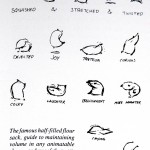Interfaces and Animation
 Monday, February 2, 2009 at 1:16AM
Monday, February 2, 2009 at 1:16AM Motion can supplement the communication of computers, to good and bad effect. In recent years, simple animation in computer interfaces is becoming less and less costly as GPU power is rockets skyward and new animation APIs require less coder-time to implement. It is therefore a wonderful time to consider utilizing animation as an additional channel for communication. But can simple shapes and icons get across consistent messages through animation?
Apparently so. The Orphan Film Symposium examines the work of psychology professors Fritz Heider and Marianne Simmel. In 1944 they created a short film illustrating the emotive potential of basic shapes. The film was shown to test subjects. The research assessed the ability for motion alone to portray emotion or a story in a consistent way — it turned out that motion alone could impart emotion. Subjects reported emotions in the story relating to bullying and other conflict. This is possibly due to the desire to see a human element in many non-human forms, called anthropomorphism.
Disney's research has also proved to be a gold mine for me; the Disney animation studio spent years mastering the art of making inanimate objects expressive. The following example is taken from the enthralling The Illusion of Life by Frank Thomans and Ollie Johnston.
 Used without permission. Will take down on request.
Disney also researched and developed, over many years, fundamental techniques to make animated emotion "feel" right. You can read a basic description of these techniques that John Lasseter in a handout presented to SIGGRAPH titled Principles of Traditional Animation Applied to 3D Computer Animation. These techniques are:
Used without permission. Will take down on request.
Disney also researched and developed, over many years, fundamental techniques to make animated emotion "feel" right. You can read a basic description of these techniques that John Lasseter in a handout presented to SIGGRAPH titled Principles of Traditional Animation Applied to 3D Computer Animation. These techniques are:
- Squash and Stretch
- Timing and Motion
- Anticipation
- Staging
- Follow Through and Overlapping Action
- Straight Ahead Action and Pose-to-Pose Action
- Slow In and Out
- Arcs
- Exaggeration
- Secondary Action
- Appeal
- The system is waiting for some input or data tranmission
- The system is processing information
- The system is sleeping
- 'Spanner in the works'?
- There is something outstanding which requires your attention
- I don't know
- Configuring…
- Finishing configuring
- Testing
- Hard work
…[just] as Disney developed these principles for creating lifelike motion for their characters, there are techniques for designing abstract motions that are not (necessarily) lifelike, but expressive of emotions and causality. I used "mood boards" to identify shapes, forms, motions that might communicate each emotion (there is an example of a mood board in the paper, which, of course, you can use). Heider and Simmel used abstraction of actual human behavior (you can almost replace the shapes with people). And, I am sure there are other techniques that others have developed.So motion can convey meaning, whether it be anthropomorphic (human-like) or not. Could subtle animation ever be a part of most interfaces? How much motion is too much? Are the current animations good or bad?
 Keith Lang |
Keith Lang |  1 Comment |
1 Comment | 